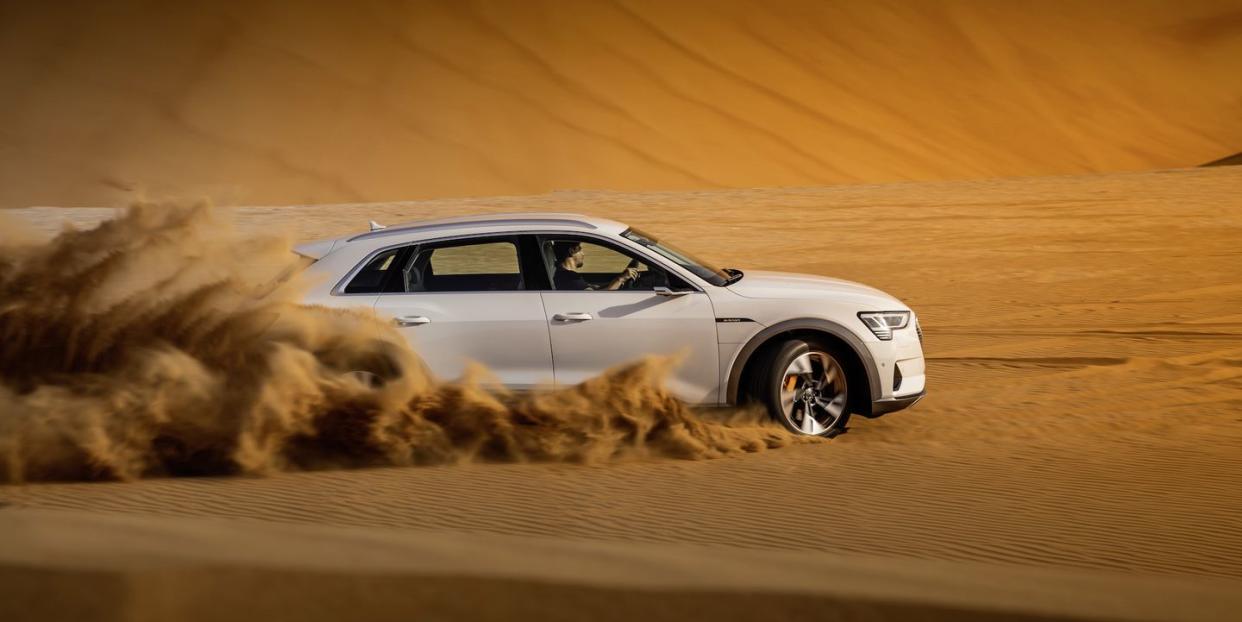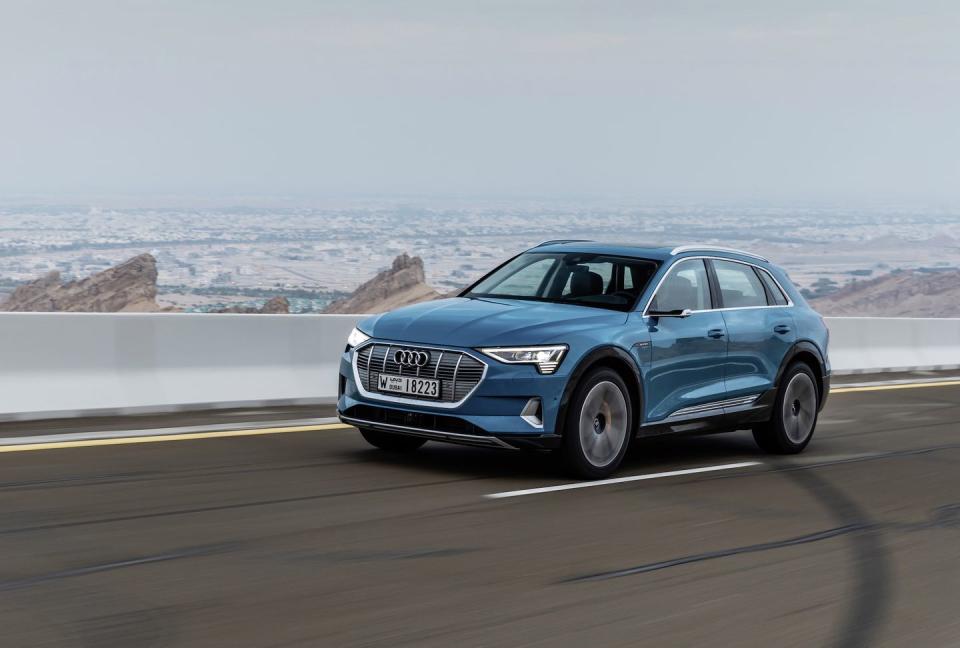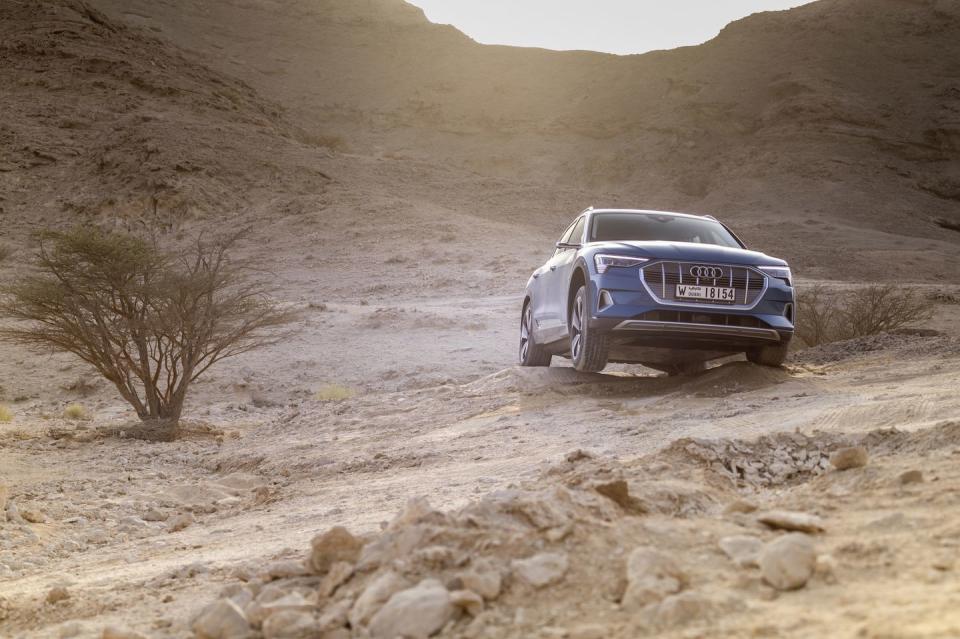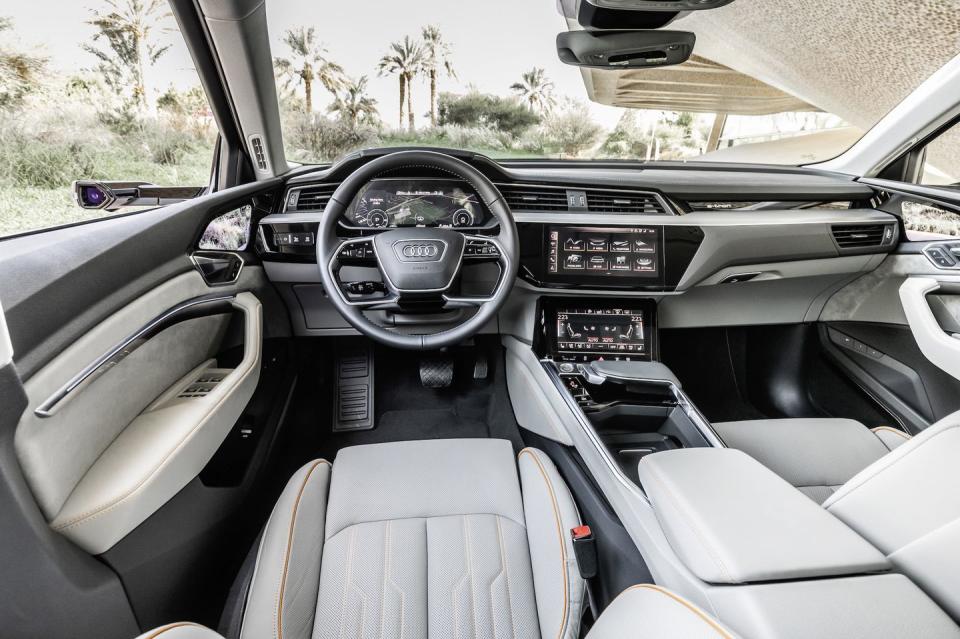The 2020 Audi e-tron Will Be the First Electric SUV You’ll Actually Want to Buy

The irony of ripping through the oil-rich desert in the United Arab Emirates in Audi’s new 2019 e-tron, an all-electric SUV, is enough to draw a chuckle. Perching Audi’s vision for the future of mobility atop a windswept dune somewhere in between Al Ain and Abu Dhabi, and the metaphorical game of king of the (fuel) hill becomes literal. Electrification is here, and it wants to zap fossil fuels into yesteryear.
Audi’s selection of the Middle East as the perfect backdrop to launch its first foray into fully electric vehicles wasn’t accidental. Tester e-trons were allocated in Masdar City, an urban residential and commercial oasis nestled on the outskirts of Abu Dhabi, purposefully built to be zero-carbon emissions. Heavily funded by the UAE government, Masdar’s promise of a fossil fuel-less future is still underway, with construction slated to complete a decade from now, and while it’s currently more a ghost town than a booming example of renewable energy, it represents the start of the tides turning.

And that’s something Audi’s parent company, Volkswagen Group, can strongly relate to. Despite producing more than 10 million vehicles with combustion engines in 2017, Volkswagen Group is planning to launch 27 electric vehicles by 2022, at a cost of $50 billion dollars. The e-tron represents a solid start to that push, a luxury battery electric vehicle that adheres closely to Audi’s brand DNA.
That means there’s a lot to love about the e-tron. Audi didn’t set out to reinvent the electric utility vehicle-a market segment already containing Tesla’s Model X and Jaguar’s I-Pace, and soon, Mercedes-Benz’s EQC and Rivian’s R1S. Instead of radical swooping lines that designers tend to impart on electric vehicles, the e-tron looks like every other Audi rolling off the assembly line: modern, clean, sporty and a bit aggressive. It’s even more handsome in person, especially when dipped in Antigua Blue metallic paint.

Inside, all the finer creature comforts await. Heaps of Valcona leather, fine grain ash inlays, massaging seats, contour LED lighting, the easy-to-use multimedia interface (spread out over several large touch screens), a Bang and Olufsen speaker system, and more. Ample legroom in the rear means passengers over six-feet tall won’t be cramped and the lack of conventional drivetrain running down the center of the vehicle allows more room for storage.
Beneath the floorboard sits a 95 kWh battery pack that powers two motors, one per axle. The rear is slightly larger than the front, but together, they provide up to 408 horsepower and 489 lb-ft of torque. The system is punchy, but it’s not “ludicrous” fast, like aModel X. The shuffle to 60 takes 6.6 seconds, though a boost mode-a ten-second session where the motors overdrive for maximum power, achieved by matting the accelerator-will shave about a second off that time.

On the flat, silky-smooth roads of Abu Dhabi, the e-tron proves itself a sedate highway cruiser. The assistance systems help to automate acceleration, braking and lane-changing with ease, though the exterior camera system in lieu of traditional mirrors proved to be more of a hindrance than a help. Small OLED screens mounted in the doors below the cameras take some getting used to since that’s not the natural place for your eye to fall when checking traditional mirrors, but presumably with time, drivers will adapt.(Audi’s lobbying for the system to come to the U.S., though it’s currently only approved for Europe.)
Part of the rationale behind the cameras is to increase efficiency while reducing noise. Audi spent mountains of time and money in pursuit of “the sound of silence,” as engineers internally dubbed the endeavor. Combustion engine consumers don’t mind the engine noise and the accompanying road noise, much of which stems from conventional side mirrors slicing through the air. But a battery electric customer wants to hear a pin drop at 70 miles an hour, so Audi employed sound deadening in places it hasn’t before. There’s foam everywhere, inside the door panels, even inside the wheels to help hush the tires. The e-tron engineers’ efforts were successful: you can clearly hear a passenger’s breathing while pushing 80 down the highway.

The ride itself is supple in comfort mode, and stiffens a bit when sport mode is engaged. That 1,500 pound battery low in the middle of the chassis helps keep the e-tron planted, no matter how hard you’re flogging the 5,500-pound brute. Torque vectoring helps keep the power to the wheels that need it most and even under the most dynamic driving situations, like flying up Jebel Hafeet Mountain Road, near Abu Dhabi. There’s no understeer and the adaptive air-suspension, borrowed from the Q7, helps the e-tron turn in precisely when and where you want it to. The steering goes slightly light under hard acceleration, but that probably won’t bother future owners.
What may cause prospective buyers to bristle is the range of the e-tron. Audi coyly deflected queries, stating all would be revealed after the EPA rating, but the unofficial consensus is the e-tron has a capacity to get between 200 and 220 miles. That’s nearly a third less than the 295 mile range of Tesla’s Model X 100D. Even Jag’s I-Pace clocks in at 234 miles, so while the e-tron is close, it’s still under the competition for now. While we racked up more than 300 miles-with a charging break in the middle-the energy dissipated faster than estimated, but we were on highways with a speed limit of more than 100 at points, so our test drive wasn’t exactly an indicator of a real use case.

While range anxiety is a real issue for some buyers, manufacturers are trying to pivot the conversation with trepidatious buyers from those stats to a different consideration: charging time. And Audi’s ain’t half bad. The standard metric is the time to charge to80 percent, due to the battery cells being unable to accept electrons as quickly the fuller they get, and Audi’s able to get to 80 percent in 27 minutes. Compared to filling the gas tank, that’s an eon, but compared to the 40 minutes it’ll take a Model X on a supercharger, that’s pretty quick. In fact, if you plug the e-tron’s into a fast charger (Level 3 DC 150k kW), you’ll be to 100 percent in 45 minutes. You can also use regular 240-volt outlets to get a full charge, as there are ports for both on the side of the e-tron, but don’t plan on going anywhere for at least nine, possibly 12 hours. (Volkswagen group is working with Electrify America to give e-tron owners access to more than 500 fast chargers across 40 states by this summer, and owners will get 1,000kWh of charging free, affording some 2,000 miles of driving.)
With a battery electric vehicle, the name of the game is efficiency, and with some throttle and brake consideration, the e-tron can help recoup an admirable chunk of the energy it expends. Audi’s existing program called Predictive Efficiency Assistant comes standard to help train drivers, by using GPS routes and its cameras to monitor other vehicles and traffic signs. If the computer senses a slow down in traffic ahead, a little green foot icon blinks on your dash, letting you know to ease off the throttle and let the car coast. In cities where car-to-x is enabled, your Audi will know that it’s about to encounter a red light and alert you. Adhere to the suggestion and you shouldn’t need to use the brakes to roll to a complete stop, as we repeatedly experienced in Abu Dhabi.

But how the EUV recoups the energy is truly innovative. The e-tron uses a brake-by-wire system that employs the motors to slow the car and recapture that energy from the wheels. Audi’s figured out that you don’t need them 90 percent of the time, for stopping situations under .03 gs, so even if you’re hitting the brake pedal, you’re not actually using the hydraulic brakes. Instead, a tiny fluid reservoir behind the firewall fills up, simulating a traditional brake pedal feel, but really, the engines are doing the work. It’s easy to read this and not think much of it, but this is a giant deal, as no other electric car has ever done this. Hit the brakes on a Tesla and the hydraulic brakes bite down on the rotor and recuperation is added to that, but Audi’s sees that method as wasted energy and ingeniously decided to separate the two systems. Granted, the e-tron can tell if you actually do need friction brakes and they will absolutely work, but even during hard driving, we only saw those step in about 10 percent of the time.
For example, when climbing up Jebel Hafeet Mountain, we burned through about 12 kWh, but the system was able to return about 10 kWh to the battery on the way back down. Not too shabby, e-tron.

Most importantly, all that technology translates to a superbly fun driving experience. A small section of dune driving afforded the opportunity to switch the e-tron into Offroad mode, which raises the ute up a bit, and just thrash it. If you haven’t drifted a 5,500-lbSUV sideways through sand dunes, I highly recommend it. Even on the straights, at speeds above 80, the e-tron sopped up the sandy bumps with pleasure, drawing laughter from this driver. It’s not a typical use-case for a $74,800 electric vehicle, but it’s certainly a riotous one.
Audi’s e-tron may not be the quickest, fastest, nor most radical-looking electric SUV, but it is the perfect transition vehicle for people who want to ditch combustion cars in favor of a hard-charging vision of the future.
('You Might Also Like',)

